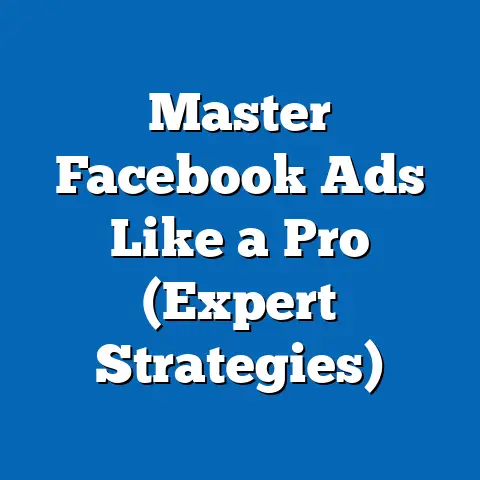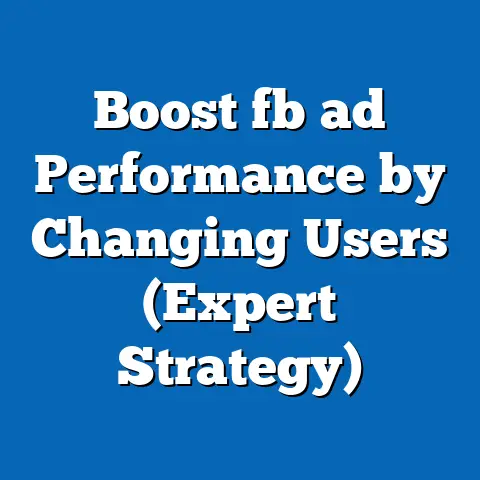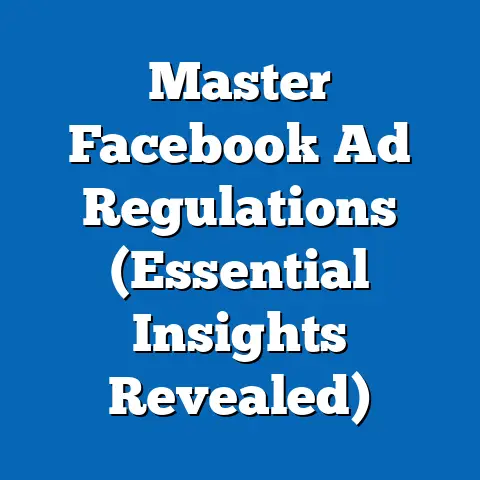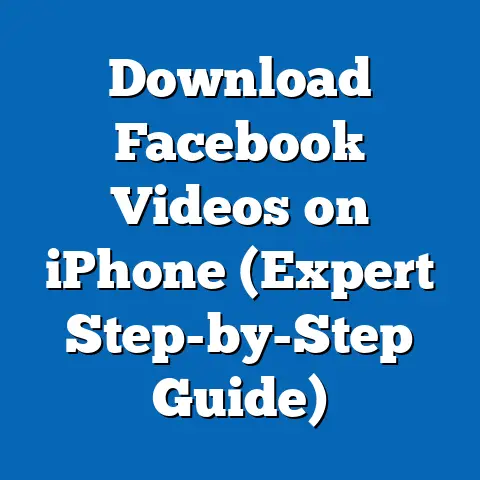Transform Feed: Uncover fb ad Optimization Secrets (Expert Insights)
I’ve been in the digital marketing game for a while now, and one thing that’s consistently surprised me is how often we overlook accessibility in our Facebook ad campaigns. It’s easy to get caught up in targeting specific demographics or crafting the perfect visual, but ensuring our ads are usable and understandable by everyone, including individuals with disabilities, is not only the right thing to do, it’s also smart business.
Think about it: when you make your ads accessible, you’re not just being inclusive; you’re also expanding your potential audience. More eyes on your ads mean more engagement, better performance metrics, and ultimately, higher conversion rates. In this article, I’m going to share some expert insights and practical tips on how to transform your Facebook ad feed by focusing on optimization secrets that many overlook, starting with accessibility.
Section 1: Understanding the Facebook Ads Ecosystem
Before diving into the optimization secrets, let’s quickly recap the Facebook Ads ecosystem. It’s a complex but powerful tool, and understanding its components is crucial for success.
Types of Facebook Ads
Facebook offers a variety of ad formats to suit different marketing goals:
- Carousel Ads: These ads allow you to showcase multiple images or videos within a single ad unit. I’ve found them particularly effective for e-commerce businesses looking to display a range of products.
- Video Ads: Video is king! Engaging video ads can capture attention and tell your brand’s story. Keep them short, sweet, and optimized for mobile viewing.
- Image Ads: Simpler than video, but still effective. Use high-quality, eye-catching images that are relevant to your target audience.
- Slideshow Ads: A great alternative to video ads when you don’t have the resources to create a full video. You can create a slideshow from a series of images.
Each ad type serves a primary function, whether it’s driving traffic to your website, generating leads, or increasing brand awareness.
Navigating the Facebook Ads Manager
The Facebook Ads Manager is the central hub for creating, managing, and analyzing your ad campaigns. Here’s a quick rundown of its key features:
- Campaign Objectives: Choose your campaign objective based on what you want to achieve (e.g., awareness, consideration, conversion).
- Targeting Options: Facebook’s targeting options are incredibly granular. You can target users based on demographics, interests, behaviors, and more.
- Budgeting: Set your daily or lifetime budget. I usually recommend starting with a smaller budget and scaling up as you see positive results.
- Bidding Strategies: Choose from various bidding strategies, such as lowest cost, cost cap, or target cost.
Introducing the “Transform Feed”
The “Transform Feed” concept refers to the continuous process of optimizing your Facebook ad campaigns based on data, expert insights, and emerging trends. It’s about constantly evolving your strategies to improve performance and achieve your marketing goals.
Takeaway: Familiarize yourself with the Facebook Ads ecosystem, including the different ad types and the features of the Ads Manager. The “Transform Feed” is a mindset of continuous improvement and optimization.
Section 2: Key Principles of Facebook Ad Optimization
Now that we have a foundation, let’s delve into the core principles of Facebook ad optimization.
Relevance, Engagement, and Conversion
These are the three pillars of successful Facebook advertising:
- Relevance: Your ads must be relevant to your target audience. Use precise targeting options and create ad copy that resonates with their interests and needs.
- Engagement: Aim for high engagement rates (likes, comments, shares). Engaging ads are more likely to be seen by a wider audience and drive positive results.
- Conversion: Ultimately, you want your ads to drive conversions (e.g., sales, leads, sign-ups). Optimize your landing pages and calls-to-action to maximize conversion rates.
The Role of Algorithms
Facebook’s algorithm plays a crucial role in determining which ads are shown to which users. Understanding how the algorithm works is essential for optimizing your campaigns.
- Relevance Score: Facebook assigns a relevance score to each ad based on its perceived relevance to the target audience. Higher relevance scores lead to lower costs and better ad delivery.
- Ad Auction: Facebook uses an auction system to determine which ads are shown. Your bid, relevance score, and estimated action rates all influence your chances of winning the auction.
A/B Testing: The Cornerstone of Optimization
A/B testing, also known as split testing, is the process of comparing two versions of an ad to see which one performs better. It’s a powerful tool for optimizing your ad creatives, targeting strategies, and bidding strategies.
- Test One Variable at a Time: To get accurate results, only test one variable at a time (e.g., headline, image, call-to-action).
- Use Sufficient Sample Size: Make sure you have enough data to draw statistically significant conclusions.
- Iterate and Improve: Use the results of your A/B tests to continuously improve your ad campaigns.
Takeaway: Focus on relevance, engagement, and conversion. Understand how Facebook’s algorithm works and use A/B testing to continuously optimize your campaigns.
Section 3: Expert Insights on Effective Ad Creation
Creating effective Facebook ads is both an art and a science. It requires a blend of creativity, data analysis, and a deep understanding of your target audience.
High-Quality Visuals and Compelling Copy
The first thing that grabs a user’s attention is the visual element of your ad. Use high-quality images or videos that are visually appealing and relevant to your brand.
- Images: Use bright, eye-catching images that stand out in the newsfeed.
- Videos: Keep your videos short, engaging, and optimized for mobile viewing.
Your ad copy should be clear, concise, and compelling. Highlight the benefits of your product or service and include a strong call-to-action.
Balancing Creativity and Data-Driven Strategies
While creativity is important, it’s equally important to base your ad creation decisions on data. Use Facebook’s analytics tools to track the performance of your ads and identify areas for improvement.
- Track Key Metrics: Monitor metrics such as CTR, CPC, and conversion rate.
- Analyze Audience Insights: Use Facebook’s audience insights tool to learn more about your target audience’s interests, behaviors, and demographics.
- Iterate Based on Data: Continuously refine your ad creatives and targeting strategies based on the data you collect.
Takeaway: Combine high-quality visuals and compelling copy with data-driven insights to create effective Facebook ads. Creativity should be informed by data analysis.
Section 4: Targeting and Audience Segmentation
Targeting the right audience is crucial for the success of your Facebook ad campaigns. Facebook offers a wide range of targeting options, allowing you to reach specific demographics, interests, and behaviors.
Leveraging Facebook’s Audience Insights Tool
Facebook’s Audience Insights tool provides valuable information about your target audience, including their demographics, interests, behaviors, and purchase patterns. Use this tool to refine your targeting and create more relevant ads.
- Demographics: Target users based on age, gender, location, education, and more.
- Interests: Target users based on their interests and hobbies.
- Behaviors: Target users based on their online and offline behaviors.
Advanced Targeting Options
In addition to basic targeting options, Facebook offers several advanced targeting features that can help you reach even more specific audiences.
- Lookalike Audiences: Create a lookalike audience based on your existing customers or website visitors. This allows you to reach new users who are similar to your best customers. I’ve seen this work wonders, particularly when targeting 1-3% of a country population that matches my existing customer base.
- Custom Audiences: Upload a list of your customers or website visitors to create a custom audience. You can then target these users with specific ads.
Takeaway: Use Facebook’s audience insights tool to refine your targeting and create more relevant ads. Leverage advanced targeting options such as lookalike audiences and custom audiences.
Section 5: Budgeting and Bidding Strategies
Setting the right budget and choosing the right bidding strategy are critical for maximizing the ROI of your Facebook ad campaigns.
Effective Budgeting Strategies
There are two main budgeting options on Facebook:
- Daily Budget: Set a daily budget that Facebook will spend each day.
- Lifetime Budget: Set a total budget for the entire campaign.
I typically recommend starting with a daily budget and scaling up as you see positive results. It’s also important to monitor your ad spend closely and adjust your budget as needed.
Bidding Strategies
Facebook offers several bidding strategies to choose from:
- Lowest Cost: Facebook will try to get you the most results for your budget.
- Cost Cap: Set a maximum cost per result that you’re willing to pay.
- Target Cost: Tell Facebook what your target cost per result is, and they’ll try to achieve that.
The best bidding strategy for you will depend on your campaign goals and budget.
Takeaway: Choose the right budgeting and bidding strategies for your campaign goals. Monitor your ad spend closely and adjust your budget as needed.
Section 6: Measuring Success: Key Performance Indicators (KPIs)
Tracking the right KPIs is essential for measuring the success of your Facebook ad campaigns and identifying areas for improvement.
Important KPIs to Track
Here are some of the most important KPIs to track:
- CTR (Click-Through Rate): The percentage of people who see your ad and click on it.
- CPC (Cost Per Click): The cost you pay each time someone clicks on your ad.
- Conversion Rate: The percentage of people who click on your ad and complete a desired action (e.g., purchase, sign-up).
- ROAS (Return on Ad Spend): The amount of revenue you generate for every dollar you spend on advertising.
Setting Realistic Goals
It’s important to set realistic goals for your KPIs based on industry benchmarks and past campaign performance. Don’t expect to achieve a 10% CTR overnight. Start with smaller goals and gradually increase them as you improve your campaigns.
Interpreting Data Analytics
Analyzing your data analytics is crucial for understanding the performance of your ad campaigns and identifying areas for improvement. Look for patterns and trends in your data to inform your future advertising strategies.
Takeaway: Track the right KPIs, set realistic goals, and analyze your data analytics to continuously improve your Facebook ad campaigns.
Section 7: Common Pitfalls and How to Avoid Them
Even experienced advertisers can make mistakes when running Facebook ad campaigns. Here are some common pitfalls to avoid:
Targeting Too Broadly
One of the most common mistakes is targeting too broad of an audience. This can lead to wasted ad spend and poor results. Use Facebook’s targeting options to narrow down your audience and reach the right people.
Neglecting to Optimize for Mobile
The majority of Facebook users access the platform on their mobile devices. If your ads aren’t optimized for mobile, you’re missing out on a huge opportunity. Make sure your ads are mobile-friendly and load quickly on mobile devices.
Ignoring Accessibility
As I mentioned at the beginning, neglecting accessibility is a major pitfall. Ensure your ads are usable and understandable by everyone, including individuals with disabilities.
- Alternative Text: Add alternative text to your images so that screen readers can describe them to visually impaired users.
- Captions: Add captions to your videos so that deaf and hard-of-hearing users can understand the content.
- Color Contrast: Use sufficient color contrast to make your ads readable for users with visual impairments.
Troubleshooting Issues
If you’re experiencing issues with your ad performance, don’t panic. Take a step back and analyze the data. Look for patterns and trends that can help you identify the problem.
- Relevance Score: If your relevance score is low, try improving your ad creatives or targeting.
- Engagement Metrics: If your engagement metrics are low, try creating more engaging content or targeting a more relevant audience.
Takeaway: Avoid common pitfalls such as targeting too broadly, neglecting to optimize for mobile, and ignoring accessibility. Troubleshoot issues by analyzing your data and looking for patterns.
Section 8: Future Trends in Facebook Advertising
The world of Facebook advertising is constantly evolving. Here are some emerging trends to watch out for:
The Rise of Video Content
Video content is becoming increasingly popular on Facebook. Create engaging video ads that capture attention and tell your brand’s story.
Influencer Partnerships
Partnering with influencers can be a great way to reach new audiences and build brand awareness. Find influencers who are relevant to your niche and have a strong following on Facebook.
The Integration of AI
Artificial intelligence (AI) is playing an increasingly important role in Facebook advertising. Facebook is using AI to improve ad targeting, optimize bidding strategies, and personalize ad experiences.
The Impact of Privacy Regulations
Changes in privacy regulations and user behavior are also impacting Facebook advertising. Stay up-to-date on the latest privacy regulations and adjust your advertising strategies accordingly.
Takeaway: Stay up-to-date on emerging trends in Facebook advertising, such as the rise of video content, influencer partnerships, and the integration of AI. Be aware of the potential impact of changes in privacy regulations and user behavior.
Conclusion: The Path to Successful Facebook Ad Optimization
Transforming your Facebook ad feed requires a commitment to continuous improvement and optimization. By focusing on accessibility, leveraging expert insights, and staying up-to-date on emerging trends, you can achieve success in the competitive landscape of digital marketing.
Remember to:
- Prioritize Accessibility: Make your ads usable and understandable by everyone.
- Seek Expert Insights: Learn from industry experts and stay up-to-date on the latest best practices.
- Embrace A/B Testing: Continuously test and optimize your ad creatives and targeting strategies.
- Track Your KPIs: Monitor your key performance indicators and analyze your data to identify areas for improvement.
- Stay Informed: Keep up with the latest trends and changes in the Facebook advertising ecosystem.
By following these guidelines, you can transform your Facebook ad feed and achieve your marketing goals. Now go out there and create some amazing ads!






